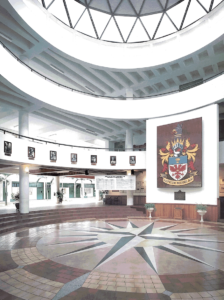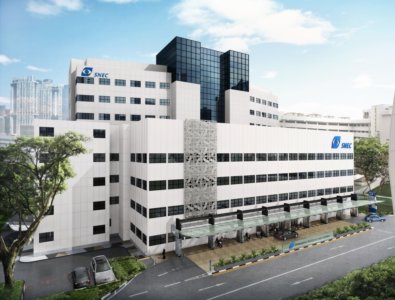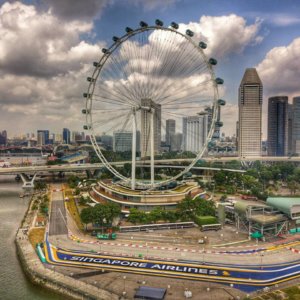The international career of Singapore architect John Ting (BArch’83)

John in Venice
John Ting (BArch ’83) is a partner at A.I.M. and associates (Singapore), an award winning multidisciplinary firm in with offices across Asia. Since being founded in 1973, the firm has built a reputation for high quality design and client focused service. The firm’s international portfolio included health science, education and housing, hotels and resorts, and large multi use developments. After obtaining his architectural education at the University of Toronto and Dalhousie University (TUNS), John returned to Singapore and joined the firm in 1984, becoming partner in 1988. Read on to learn about his career path and some great memories from days gone by that you may remember too!
Why did you choose to study Architecture at Dal (then TUNS!)?
I was studying arts & sciences as an undergraduate at the University of Toronto and I had two friends with similar interests who helped me make the decision. One, Craig Applegath (BArch ’84), had researched all the schools of architecture in Canada and had chosen TUNS. Another invited me to me to dinner with his uncle, a design partner at John Parkin and Associates, who was aware of the reputation of the school and encouraged me to apply.
What was memorable about your time in school?
The entire time was memorable, starting with the first assignment given by the Dean – to write a 50-word-essay on the reasons to study architecture. I may have been the only one who passed his “test” because he literally counted the number of words and mine was under 50!

Halifax Harbour
The friendships experienced during those hair-raising overnights in the studio trying to complete our design assignments (I can laugh about these now). Attending the post critique pub-crawls as a teetotaller was an experience I will never forget! Sunrise over the harbour of Halifax is beautiful and mesmerizing.
One of the best aspects of my education was the work terms outside of school. My experience at the Ministry of Health and at Jerome Markson (both in Toronto), were precious and much cherished because it was my first exposure to the profession in the “real world”.
One Christmas holiday we took a road trip to New York City. We squeezed into two small hotels rooms at the Taft (named after President William Howard Taft) in order to experience the city and complete visits to all the museums before embarking on a design assignment on museums. The Guggenheim, MOMA, MET, and especially The Frick Collection at the Henry Clay Frick House, were amazing and inspiring. To witness the spectacular Times Square Ball and New Year Eve fireworks, located in New York City’s Times Square, is memorable indeed.
A few of us once took a drawing course at the NSCAD, and it was quite a different experience learning alongside students of the arts.
My final thesis year was amazing because I collaborated with a mature student, Frank Mayo, who had about 40 years work experience under his belt before he decided to finish his formal studies in architecture on a part-time basis. We had so much fun exchanging ideas, discussing, deliberating and debating all kinds of matters, ranging from architecture to life. He appreciated my in depth understanding of the discipline while I delighted in his sharing of real life situations and solutions.
What was you path post graduation? What does your career look like today?
After graduation I returned to Toronto to attempt to find work during the worst economic years in Canada when most architects were unemployed or under-employed. I managed to find an offering with Jedd Jones Architects. Jedd was a former colleague of George Baird, with whom I had worked during my work term at Jerome Markson Architects. Unfortunately I was not able to obtain a work permit to stay in Canada, so I returned to the Far East.

Raffles Institution
My next destination was Singapore where I was engaged as a graduate design architect by an International Australian architectural and planning firm for a year. I joined AIM & Associates in 1984 and was involved with a condominium, housing shop-houses, township planning, and a specialist medical centre in Sabah, East Malaysia. In 1985/86 I was the key designer leading the team that won a national design competition for a Junior College. This college was to be the 2nd reincarnation of the Raffles Institution, the premier High School in Singapore. The Raffles Institution was founded in 1823 and has produced many Cabinet Ministers, including the first and second Prime Ministers of Singapore. In 1986 we competed and won several design competitions, including the first Ophthalmology Centre in Singapore. The SNEC (Singapore National Eye Centre) has since established itself into a foremost ophthalmology centre in Asia.

Singapore National Eye Centre
I became a partner of AIM & Associates in 1988 and have been managing it since. Besides professional practice, I am active at the universities and professional institution.
I was an adjunct, thesis supervisor and visiting critic at the School of Architecture at the National University of Singapore from 1984 to 2004. I am a visiting critic in the Architecture Sustainability Design Program at the Singapore University of Technology and Design (which started as a joint institution between MIT and SUTD) since 2015.
I have been active at the Board of Architects and the Singapore Institute of Architects and was the duly elected President of SIA for 2002-2003 and 2003-2004.
What are your most memorable projects? Which are most proud of?

Singapore Flyer
Like a typical architect I will say my most memorable project is “the next one”! A few I am very proud to have worked on are the Raffles Institution, the SNEC, and the Singapore Flyer (the Giant Observation Wheel) conceptualized by the late Dr. Kishio Kurukawa.
Have you won any awards of which you are particularly proud?
The Raffles Institution was a prize-winning design and was recognized by the Building Construction Authority. I was honoured with Young Architect of the Year (under 40) jointly awarded by Sir Norman Foster and the British High Commission in Singapore.